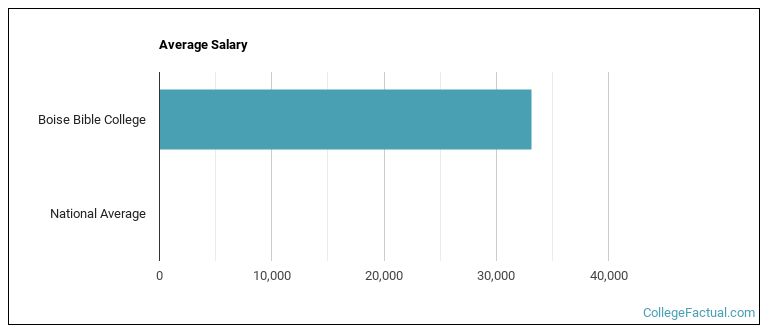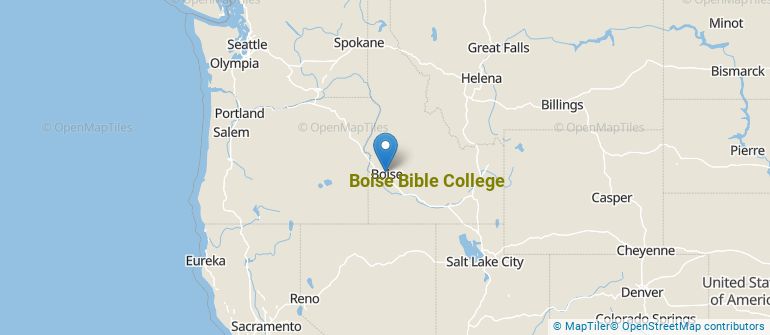 by our College Data Analytics Team
by our College Data Analytics TeamExplore the best ranked schools for the programs you are most interested in.
Boise Bible College was not ranked in College Factual's 2025 Best Overall Colleges report. This could be for a number of reasons, including lack of data.
With an acceptance rate of 100%, Boise Bible College is easier to get into than many other schools. But that doesn't mean you can slack off on your application. Make sure to treat this school like any other when submitting requested materials and documents.
About 43% of students accepted to Boise Bible College submitted their SAT scores. When looking at the 25th through the 75th percentile, SAT Evidence-Based Reading and Writing scores ranged between 400 and 530. Math scores were between 410 and 580.
At Boise Bible College, the student to faculty ratio is an excellent 11 to 1. That's much better than the national average of 15 to 1. This indicates that many classes will probably be small, and students will have ample opportunites to work closely with their professors and classmates.
When estimating how much access students will have to their teachers, some people like to look at what percentage of faculty members are full time. This is because part-time teachers may not have as much time to spend on campus as their full-time counterparts.
The full-time faculty percentage at Boise Bible College is 92%. This is higher than the national average of 47%.
The freshmen retention rate tells us what percentage of first-year, full-time students choose to continue on to their sophomore year at a particular school. The rate at Boise Bible College is 72%, which is about average when compared to the national rate of 68%.
When we say that a student has graduated on time, we mean that they have finished their bachelor's degree within four years. The on-time graduation rate at Boise Bible College is 25%. That's lower than the national rate of 33.3%
Find out more about the retention and graduation rates at Boise Bible College.
During the 2017-2018 academic year, there were 101 undergraduates at Boise Bible College with 82 being full-time and 19 being part-time.
The net price is calculated by adding tuition, room, board and other costs and subtracting financial aid.Note that the net price is typically less than the published for a school. For more information on the sticker price of Boise Bible College, see our tuition and fees and room and board pages.
While almost two-thirds of students nationwide take out loans to pay for college, the percentage may be quite different for the school you plan on attending. At Boise Bible College, approximately 44% of students took out student loans averaging $4,615 a year. That adds up to $18,460 over four years for those students.
The student loan default rate at Boise Bible College is 6.0%. This is significantly lower than the national default rate of 10.1%, which is a good sign that you'll be able to pay back your student loans.

See which majors at Boise Bible College make the most money.
Get more details about the location of Boise Bible College.

Contact details for Boise Bible College are given below.
| Contact Details | |
|---|---|
| Address: | 8695 W Marigold St, Boise, ID 83714-1220 |
| Phone: | 208-376-7731 |
| Website: | https://www.boisebible.edu/ |
| Most Popular Majors | Bachelor’s Degrees | Average Salary of Graduates |
|---|---|---|
| Biblical Studies | 7 | NA |
| Pastoral Counseling & Specialized Ministries | 5 | NA |
| Missionary Studies | 3 | NA |
| Sacred Music | 3 | NA |
| Theological & Ministerial Studies | 2 | NA |
| General Education | 1 | NA |
| General Psychology | 0 | NA |
| Religious Education | 0 | NA |
Online courses area a great option for busy, working students as well as for those who have scheduling conflicts and want to study on their own time. As time goes by, expect to see more and more online learning options become available.
In 2022-2023, 2 students took at least one online class at Boise Bible College. This is an increase from the 1 students who took online classes the previous year.
| Year | Took at Least One Online Class | Took All Classes Online |
|---|---|---|
| 2022-2023 | 2 | 1 |
| 2021-2022 | 1 | 1 |
| 2020-2021 | 0 | 0 |
| 2018-2019 | 0 | 0 |
Footnotes
*The racial-ethnic minorities count is calculated by taking the total number of students and subtracting white students, international students, and students whose race/ethnicity was unknown. This number is then divided by the total number of students at the school to obtain the racial-ethnic minorities percentage.
References
More about our data sources and methodologies.